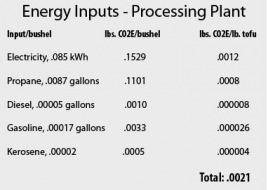Conditioning at Harmony Agricultural Products

Miller’s soybeans are just 30 miles down the road from their next destination, a “conditioning” plant run by Ohio’s Harmony Agricultural Products. Harmony contracts with farmers all over Ohio and parts of lower Michigan to grow non-GMO and organic beans.
The plant ensures that only food-grade beans, with appropriate moisture and protein content, are sent to tofu makers. They also serve a large Japanese export market; Harmony is a subsidiary of Honda, which ships its Japan-made cars into the U.S, and ships out its soybeans.
While Harmony processes both only a small amount of organic soy, “Organic has a lot higher value,” says Jerry Angst, production manager at Harmony. But Japan, as well as a few tofu producers in the U.S., is willing to pay for it.
Harmony’s soy farmers are as far away as 250 miles and as close as a half mile. Over the phone, Angst describes to me how the beans are shipped in, by hopper-bottom trucks, and dropped off at the conditioning plant.
After a careful five-step process, in which the beans are hulled and polished, the soybeans will sit in a refrigerated plant until they are ready to be shipped to their destination. Energy usage at the plant runs to an average of 6,000 kWh per month. And shipping 1,000 bushels to the plant, via diesel truck, spews more than 1,800 pounds of CO2 into the air.
In the year in question, Harmony processed 850,000 bushels of soybeans.
The plant ensures that only food-grade beans, with appropriate moisture and protein content, are sent to tofu makers. They also serve a large Japanese export market; Harmony is a subsidiary of Honda, which ships its Japan-made cars into the U.S, and ships out its soybeans.
While Harmony processes both only a small amount of organic soy, “Organic has a lot higher value,” says Jerry Angst, production manager at Harmony. But Japan, as well as a few tofu producers in the U.S., is willing to pay for it.
Harmony’s soy farmers are as far away as 250 miles and as close as a half mile. Over the phone, Angst describes to me how the beans are shipped in, by hopper-bottom trucks, and dropped off at the conditioning plant.
After a careful five-step process, in which the beans are hulled and polished, the soybeans will sit in a refrigerated plant until they are ready to be shipped to their destination. Energy usage at the plant runs to an average of 6,000 kWh per month. And shipping 1,000 bushels to the plant, via diesel truck, spews more than 1,800 pounds of CO2 into the air.
In the year in question, Harmony processed 850,000 bushels of soybeans.
